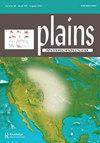Set in stone: Re-examining stone feature distribution and form on the Northwestern Plains
Q2 Social Sciences
引用次数: 1
Abstract
Recently, Reeves and Kennedy [(2017) Stone Feature Types as Observed at Ceremonial Site Complexes on the Lower Red Deer and the Forks of the Red Deer and South Saskatchewan Rivers with Ethnohistorical Discussion. Saskatchewan Archaeological Society, Saskatoon] identified a series of what they argue are unique stone feature types in the Forks area, near the village of Empress in southeastern Alberta. These researchers assert that, to their knowledge, no similar stone features exist in southwestern Alberta. They suggest that this regional difference in distribution and their absence from Blackfoot territory in southwestern Alberta indicates that they were created by the Gros Ventre as part of a distinct ceremonial practice. We examine Reeves and Kennedy’s feature types and provide examples of most from southwestern Alberta along the foothills front. We then examine the hypothesis of a Gros Ventre affiliation for these features and discuss how the evidence from southwestern Alberta informs this hypothesis and larger questions of ethnicity. While some of these stone features may have been created by the ancestral Gros Ventre, it appears others were most likely created by ancestral Blackfoot groups as part of their own cultural practice. This is supported by the presence of these feature types in southwestern Alberta and their consistent association with important landmarks and named places in the Blackfoot cultural landscape.镶嵌于石中:重新审视西北平原的石质特征分布与形态
最近,Reeves和Kennedy[(2017)在下马鹿河、马鹿河叉和南萨斯喀彻温河的仪式遗址综合体中观察到的石头特征类型与民族历史讨论]。萨斯喀彻温省考古学会(Saskatchewan Archaeological Society, sas卡通)在阿尔伯塔省东南部皇后村附近的福克斯地区发现了一系列他们认为是独特的石头特征类型。这些研究人员断言,据他们所知,阿尔伯塔西南部没有类似的石头特征。他们认为,这种分布上的地区差异以及它们在阿尔伯塔西南部黑脚地区的缺席表明,它们是由格罗斯文特人创造的,作为一种独特的仪式实践的一部分。我们研究了里夫斯和肯尼迪的特征类型,并提供了阿尔伯塔西南部沿山麓前沿的大多数特征类型的例子。然后,我们检查了这些特征的格罗斯·文特隶属关系的假设,并讨论了来自阿尔伯塔西南部的证据如何告知这一假设和更大的种族问题。虽然其中一些石头特征可能是由祖先格罗斯·文特尔创造的,但似乎其他的石头特征最有可能是由祖先黑脚人创造的,作为他们自己文化实践的一部分。这些特征类型在阿尔伯塔西南部的存在,以及它们与黑脚文化景观中重要地标和命名地点的一致联系,都支持了这一点。
本文章由计算机程序翻译,如有差异,请以英文原文为准。
求助全文
约1分钟内获得全文
求助全文

 求助内容:
求助内容: 应助结果提醒方式:
应助结果提醒方式:


